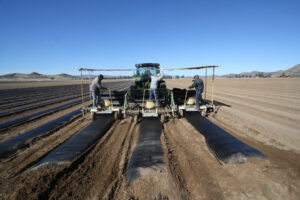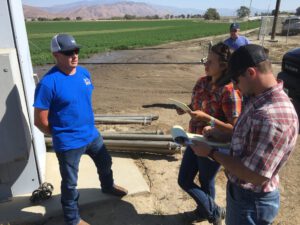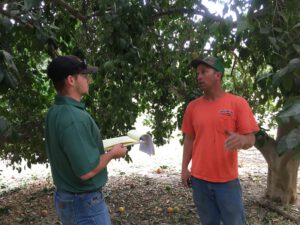In summer 2018, Eastern Municipal Water District (EMWD) of Perris, California, received a $210,000 grant from the Bureau of Reclamation to support increased water use efficiencies among its agricultural customers. The grant funding is part of the Agricultural Water Conservation and Efficiency program, a joint program between Reclamation and the National Resources Conservation Service. EMWD was one of three agencies nationally to receive program funding. The funding will support new technology to assist local agricultural producers become more efficient and to provide them with a better understanding of their water use needs. It will include real-time online tracking of water use, creating weather-based water budgets for local farms and replacing irrigation infrastructure with more water-efficient devices. Kris Polly, editor-in-chief of Irrigation Leader, spoke with Daniel Carney, RLA, EMWD’s principal water resources specialist, and Kevin Pearson, EMWD public affairs officer, about the goals of the grant project, the reasons for the application, and EMWD’s water future.
 Kris Polly: Please explain the reason EMWD applied for the grant and what the district plans to accomplish with the funding.
Kris Polly: Please explain the reason EMWD applied for the grant and what the district plans to accomplish with the funding.
Daniel Carney: We just completed an optimization review, and based on the recommendations of Dr. Charles Burt of the Irrigation Training and Research Center at Cal Poly San Luis Obispo, we selected the Agricultural Water Data Project. The project aims to improve day-to-day communications between farmers and the water district by allowing the farmers to communicate with us via their cell phones, tablets, or computers.
We also have information on the amount of water flowing into their fields on an almost real-time basis—there is about an hour delay—and we want to integrate that into a useful tool that all the farmers can use. This tool will allow farmers to see how they are doing compared to their water budget and see if there are any leaks in their systems. Even though we currently have an automated meter infrastructure, we don’t have the real-time communication link with the farmers, and that is what this grant application is for.
The second part of the grant application is more boots-on-the-ground oriented. We will be working with Dr. Burt’s team at the Irrigation Training and Research Center and with a small group of farmers who have participated in the optimization and review phase of this process to make sure that what we are doing is working for that group, and then we will expand those opportunities out to all the farmers using recycled water in our district.
Additionally, with the software, Dr. Burt and his team will do a detailed on-farm site analysis at various farms around the district. The team has a well-equipped trailer that it uses to measure pressures, flow, and uniformities. The team works with each farmer individually to see what types of improvements might be made.
The final step will be to work with the National Resources Conservation Service and possibly the EQUIP program, and based on the recommendations from Dr. Burt and his team, we’ll see what we can do as a district to help farmers take advantage of those loans, funding options, and opportunities to get new equipment. That really is the long-term goal: increased information and more efficient equipment.
Kris Polly: Are you starting with a core group of farmers on a pilot project and then looking at expanding to your entire service area?
Daniel Carney: Yes, that is the proposal. We are working internally with our information systems group. It is fairly complex on the software side: We have the automated meter infrastructure system—radio read meters on almost all our services, and all our farmer turnouts have them. There is another layer of software that needs to be integrated that will allow twoway communications to be wireless. To facilitate that, our internal information systems team recommended that we get the software placed and then start out with a small group of 10 farmers with whom we have already been working on the optimization review. We are communicating with these farmers—they supply a lot of information about their sites, and they have indicated that they would be willing to continue working with us on this second phase, the Water Data Project, if we are able to get the resources necessary to complete the phase. We are hoping that they will all end up participating; we just found out that we were awarded the grant, and we haven’t contacted the small group of farmers yet. There are always going to be updates and changes to the software, and that is why we chose to stick with the small group at first. We want to get the kinks worked out with as little trouble as possible for the core group, and then reach out to our entire group of farmers as quickly as possible with the data product.
It is important to point out that Dr. Burt and his team’s on-farm analysis is something we don’t have to wait for. My colleague Kevin Pearson will be reaching out to the farmers in our district and offering them these services at no cost to them. That can proceed as quickly as Dr. Burt and his team are available.
Kris Polly: Once Dr. Burt and his team are onsite, how long does it take them to complete their analysis?
Daniel Carney: Well, I had the good fortune to be onsite with them during the optimization review in which we essentially looked at 10 different farms, some of which are quite large. We spent about half a day per farm. We would look at point connection and the last sprinkler on the system, gathering information to help us understand the variability, pressure, and flow. I would imagine that it would be similar, depending on the size of the farm—2 to 4 hours per farm. The team members want to be efficient with their time. During the optimization study, we had a drone team onsite as well. The drone team was looking at the aerial imaging and heat maps of the water patterns. The analysis was through both land and sky to examine how they were watering and how we could help them increase efficiency and achieve a more even application pattern for their irrigation systems.
Kris Polly: Would you please describe the range and types of irrigation that your farmers are using and the crops they are growing?
Daniel Carney: I don’t think anyone has furrow irrigated in the last 20 years or so. The majority of systems that we have in our district are lateral move, manual set, and impact rotor, and we even have some pivot systems on the large turf plots. Farmers are growing a lot of alfalfa; forage crops; some specialty vegetables; and seasonal vegetables, including pumpkins; however, the majority is alfalfa. We have two primary service corridors within our system within which most of the farms tend to be clustered: One of them leans toward fruits and vegetables, and the other leans toward fodder crops for dairy feed and turf. Within those two corridors, different types of farming are going on.
Kevin Pearson: I want to add that in terms of specialty crops, we do a lot of bok choy—we are growing quite a few Asian vegetable varieties here. Microspray and microsprinkler are common on those types of crops. We do have a number of farmers who are using drip in-line emitters for the most part. We are hoping that because of the efficiency of that method, more farmers take that direction with some financial assistance.
Interestingly enough, a large amount of potatoes is grown in our district. We have a huge potato supplier that provides potatoes that ultimately supply a slew of fast-food restaurants in the area, including McDonald’s and Wendy’s. It is really awesome to see that in our district.
Kris Polly: What is the time frame for completing your project?
Daniel Carney: As it stands, the proposal, beginning to end, is not to exceed 2 years. The first phase would be internally integrating the software combined with some outreach to the farmers to get them on board and to inform them of what we are doing. The starting point for phase 2 will be based on when we can get contracts in place for the grant, but we hope to be on the ground and running in early 2019. Dr. Burt’s team could potentially be on the ground helping the farmers with the onsite analysis in late spring or early summer 2019, which is when his students are more available to help him. We would like to get as much of the communication software product in place and functioning and have a full growing year to gather some results. The first phase will be setup: getting the software installed and contacting all the farmers, doing the analysis, and then finding more efficient methods if need be. Primarily, our focus is on getting the two-way communication system up and running to give the farmers better information to help them efficiently operate their farms. The last part of the project is gathering the information and reporting.
Kris Polly: Are farmers in your district using recycled water?
Kevin Pearson: Oh, absolutely; a large portion of our farmers use recycled water. We do about 35,000 acre-feet of recycled water per year, and about 70 percent of that goes toward agriculture. It is all tertiary treated, and it is an interconnected pressurized system as well. A vast majority of our agricultural base in the district uses the recycled water. All our investments are going to greatly affect the recycled water system. We are using 100 percent of our recycled water supply each year. We are one of the few agencies in the nation that can claim that. We sell every drop that we produce.
Kris Polly: What are your motivations for pursuing this grant program?
Kevin Pearson: We understand the need for the agricultural community to have the technology and to bring everything that the 21st century has to offer onto the farm. Part of that entails having the equipment they need from us to meet those changing needs. Traditionally, agriculture has been generational within families, and as the younger group is taking over, they want new technology on the farm so they can be more efficient. They understand that it’s a business and that new technology is an investment that equates to a larger bottom line. This program does not work if the local agricultural community is not willing to try new technologies that aim to increase efficiency and grow business. When we approached the agricultural community during the first study, I think everyone we spoke to wanted to be involved. They wanted to put in the time and effort because they realized that it would help them operationally—it would help their business and help them better understand their water use. Agriculture in our district is big business; it is a $156 million industry within EMWD’s service area.
Daniel Carney: I would like to add that for many years, EMWD has been working to provide a customer portal, a two-way communication data tool, to all our customers. It is interesting that this project would be the first rollout of the customer portal to the farmers in our district. I think that speaks to the commitment of our board of directors to provide excellent service to the farmers in our district.
Kris Polly: Earlier you mentioned that you were trying to implement cell phone technology for farmers in your district. Do you have a prototype of that technology?
Daniel Carney: Yes, we certainly do. Our information systems folks are working with a software package provided by Harris Utilities. Of course, we are going to be refining and customizing it for this project. Officially, our goal is to make it an easy-to-use customer portal, similar to a banking app. We want to make it user friendly, so that farmers can make up their own water budget and use the app to better their farm. Our recycled water customers receive annual allocations, and that information would be integrated into the app; customers would be able to monitor their recycled water allocation in real time.
Kris Polly: With a pressurized system like yours, do customers have to order their water?
Kevin Pearson: No, they don’t have to order water, but each customer has an annual allocation. We typically see farmers irrigating during the day, and schools, parks, golf courses, and landscaping—areas on the recycled water system— irrigating at night when those facilities are not in active use. Our two main customer segments pulling water during opposite times of a 24-hour period tends to balance out the pressurization within the system.
Daniel Carney: From a water system operator’s point of view as well as the farmers’, this new technology is not water ordering in the traditional sense. It is communication between the district and the farmers. We are looking to optimize available pressure and flow at every farmer’s turnout, and this tool will allow us to better communicate with the farmers. One observation from phase 1 was that Farmer A does not know when Farmer B is going to be irrigating, and both farmers could be on the same pressurized mainline. If they don’t have pressure pumping, they may not have optimum pressure to irrigate. This tool will help us better help the farmers regulate the pressure and flow on any given mainline.
Kris Polly: What is the water rate structure in your district?
Kevin Pearson: We have a rate structure based on a customer’s allocation priority as well as seasonal rates. It tends to be about one-third of potable water rates, if not less.
Kris Polly: Do you have any other goals for this effort that you would like to mention?
Daniel Carney: Something that is really important in our district is water quality. EMWD is always looking at every possible source of water that we could use: desalination, groundwater, and recharging groundwater basins. One of the regulatory issues that we have with our state water quality board is making sure that the water stays where we put it. Water quality downstream, groundwater, and the quantity of water applied are all related to irrigation efficiency.
Kevin Pearson: Because a lot of our farmers are on recycled water, there is a set amount of recycled water that we have every year that is based on wastewater flows. As our agricultural community becomes more efficient, it frees up more recycled water that can be put toward other purposes. With that water saved, we could get more schools and parks on the system and engage in groundwater recharge. Making our agricultural water supply more efficient helps all our other customers, because we end up with a greater volume of supply that can be used for other purposes. This project is aimed at creating a benefit for everyone in our district; it is not just about the farmers.
Kris Polly: Finally, what was your experience working with the Bureau of Reclamation on the grant?
Kevin Pearson: I think we would be remiss if we did not thank the Bureau of Reclamation for its support in this grant opportunity. Reclamation has been an outstanding partner for a long time. Over the past 15 years, EMWD has received over $500 million in grants and low-interest loans from various funding agencies, but Reclamation provided us with funding in the 1990s that built the foundation of our recycled water system. Ever since, it has always found ways to support what we are doing, and we just want to say thank you to them. The resources that Reclamation provides are truly invaluable to projects like this and allow us to provide our customers with on-the-ground benefits as well. What Reclamation does for agencies like us often goes unnoticed; the public does not always realize how much it does. We have the infrastructure for our recycled water in place because Reclamation was willing to step up and provide us with funding decades ago. Now, we are one of the world leaders in recycled water. We wouldn’t be able to sustain our agricultural industry if Reclamation had not stepped up many years ago.
Daniel Carney is the principal water resources specialist for Eastern Municipal Water District. He can be reached at carneyd@emwd.org.
Kevin Pearson is the public affairs officer for Eastern Municipal Water District. He can be reached at pearsonk@emwd.org.


